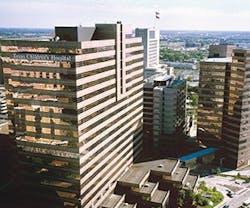A Strong Pulse for Fire Safety
Providing high-risk maternity care, the Pavilion for Women is the latest healthcare facility to join the Texas Children's Hospital campus in Houston. As a high-rise building with a specialized patient population, fire protection can be a challenge.
"On the eighth floor, we have babies in neonatal intensive care that literally fit in the palm of your hand. They can't go anywhere during a fire alarm," says Lonnie Rinehart, the hospital's plant operations manager. "For us, it all goes back to patient safety – what can we do to keep our buildings safe and our patients safer?"
The hospital partnered with FireTron, a life safety firm, and systems provider NOTIFIER to explore the best fire protection options for the facility's unique demands. The new building includes two towers, one 15 floors and the other six, that are connected at the base. Its footprint is a city block wide and two football fields long.
To maintain comprehensive fire protection, the hospital installed two fire alarm control panels, 538 smoke detectors, 248 duct-mounted detectors, 1,427 speaker/strobes, and 111 firefighter telephone jacks.
Supported by technology, building staff focus on three key areas to ensure continuous coverage: detection, inspection, and monitoring. PageBreak
Staying Ahead of Nuisance Alarms
To eliminate the possibility of nuisance alarms yet increase the chances for early detection, nearly all rooms were fitted with self-regulating detectors. These units examine a combination of environmental factors, scanning for the visual signatures of smoke and fire as well as unusual spikes in temperatures.
With the ability to automatically adjust their own sensitivity settings based on slow, minor changes within the surrounding environment, the detectors can adapt to the ever-changing needs within rooms.
"This keeps fire protection around our patients at all times, we don't alert the fire department with nuisance calls, and business operations continue without needless interruptions," says Rinehart.
Other areas require a more tailored approach. Those using aerosolizing devices for respiratory treatment, for example, would often trigger older detectors. These were replaced by newer models that identify four fire signatures: smoke, heat, infrared, and carbon monoxide. Programmable detection enables hard-to-alarm spaces such as these to have fire protection without an influx of nuisance alarms.
For real alarms, an addressable fire alarm system enables quick responses to the location in question. These systems electronically track each individual device in a building, so if one is triggered, staff can quickly pinpoint the source.
The hospital has a standard operating procedure for fire alarms – the public isn't alerted and the system sends out automatic preset emails, texts, and pages with critical information, says Rinehart. Predetermined teams of security, engineering, and a nursing administrator respond to the alarm. Security and engineering handle the event until firefighters arrive, and the nursing administrator commandeers anyone needed to handle patient safety.
The system also boasts a voice evacuation feature that can be targeted to certain areas with recorded emergency messages, explains Bob Kaczmarek, FireTron's vice president of sales and marketing. Operators have the added flexibility to give manual voice instructions. PageBreak
Leveraging Technology
Technology integration is another key measure that Texas Children's employs. By interfacing the building management system (BMS) with the life safety system, the hospital has more control over fire response.
For example, the facility must abide by a state mandate to have smoke removal systems in all operating rooms, says Kaczmarek. Operators can use the software to open and close fire and smoke dampers or start exhaust fans. The same capability applies to all security doors, which can be strategically unlocked based on their proximity to the fire.
FireTron also barcoded all device heads, strobes, panels, and other interfaces. Every test, replacement, and alert on each device can be compiled into a report. Maintenance and efficiency reporting is made more efficient. says Rinehart, and offers a greater depth of detail to facility managers and the authorities having jurisdiction alike.
Beyond the advances in the Pavilion for Women, the entirety of the Texas Children's campus is monitored from a central command station. Fire, security, and medical gas monitoring are just a few of the building systems closely supervised.
These fire safety measures are useful no matter what kind of facility you have. All it takes is an FM who's willing to make fire safety a priority.
